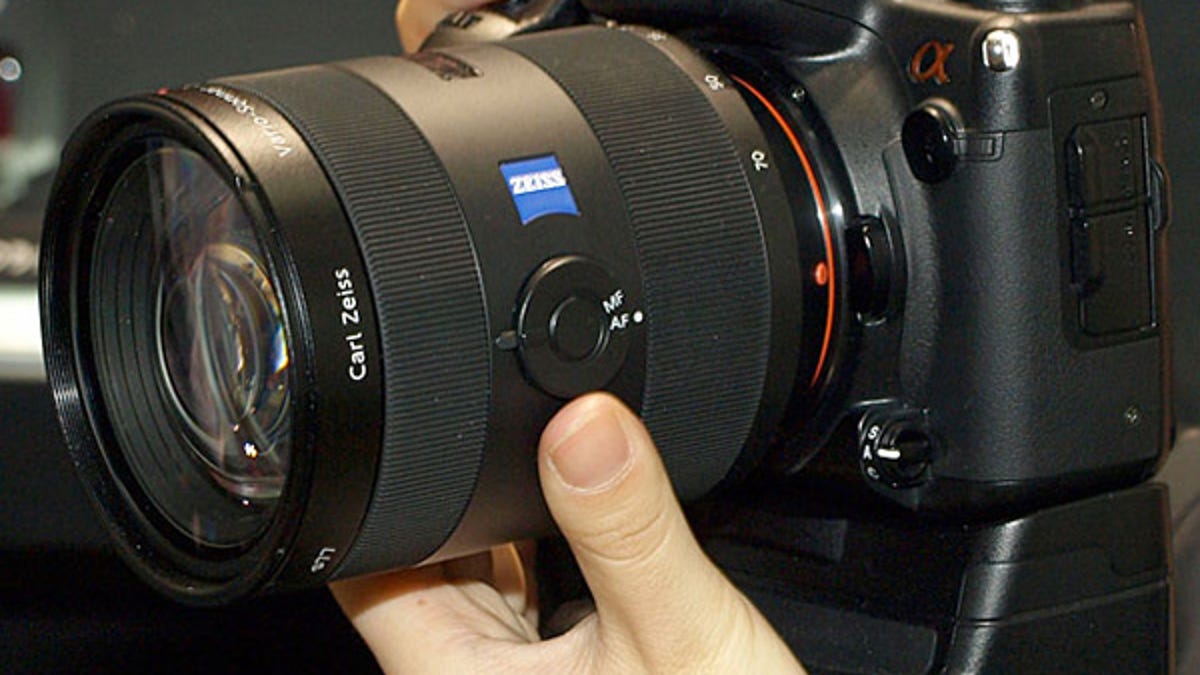Sony flagship Alpha 900 DSLR breaks cover
Sony shows a prototype of its new flagship Alpha 900 digital SLR, and it's a monster.

Continuing their march upward in digital SLRs, Sony has for the first time allowed a hands-on look at a prototype of their Alpha 900. They had previously shown it "under glass" at photo shows.
There are a few noteworthy things:
Sensor: Holy moly, a 25 megapixel full frame sensor! Be sure to bring lots of memory cards, because you are going to fill them up fast, especially if shooting RAW (and as a pro, why wouldn't you be?). This is twice as big as the 12.2MP sensor in the competing Nikon D3, currently the darling of the photo forums. There's got to be some serious computing horsepower going on inside the body, too, to process those enormous image files at a frame rate that is required for a pro-level camera. Presumably there are multiple card slots in the body, and perhaps extras in the optional battery grip.
Size: If there's one thing I learned in design school, it's to take photos of handheld products using someone with hands that make the product appear the size you want it to be. In other words, small hands make a product look bigger, and vice versa. Well, either the person holding the camera in these shots has small hands, or this is one gigantic camera! Hard to tell how it scales compared to the big Canons and Nikons, but it's clear it's a beast. No doubt stoutly made, however, for its intended professional use. Unlike Nikon and Canon, Sony have opted not to build the battery grip into the body, so that may actually allow for a lower weight than the competition if you don't need the grip all the time.
Live View: Sony's implementation of Live View in its entry-level A350 has been widely reviewed as the best approach so far, making it truly useful. (Lots of people dismiss Live View on a DSLR -- "That's what the viewfinder is for!" they say -- but the fact is that looking at a screen from a distance rather than up against the viewfinder does have its uses, even for pros who often have to hold cameras above their heads to get a shot through a crowd.) The A900 brings Live View to a pro model camera in a similarly useful way.
Pentaprism: The A900 sports a decidedly retro looking pentaprism (the block of mirrored glass that sits above the lens and sends the image into the viewfinder) that iconically takes the old angular turret look of famous pro cameras like the Nikon F3 and plops it onto a modern ergo-curvy body. It's a rather odd combination, and doesn't work to my eyes. Many people will probably say, who cares what it looks like as long as it takes great photos? And there is something to that. But for a tool that is about creating aesthetics, I've always believed that the tools themselves should be beautiful. And if you look at the classic cameras of the past, even the professional ones, they were always beautiful in their own way (F3, Leicas, Rolleiflexes, Canon T90, etc.). Beautiful doesn't have to mean Ferrari-sleek, but it does mean that the designs are coherent and have a sense of "inevitability" about them. The A900 does not have that, it looks cobbled together.
It's good to see Sony sticking with the SLR business though, there was a lot of skepticism when it bought out the Minolta range and re-badged it that they would have the patience required for this market. Check out more photos at Master Chong